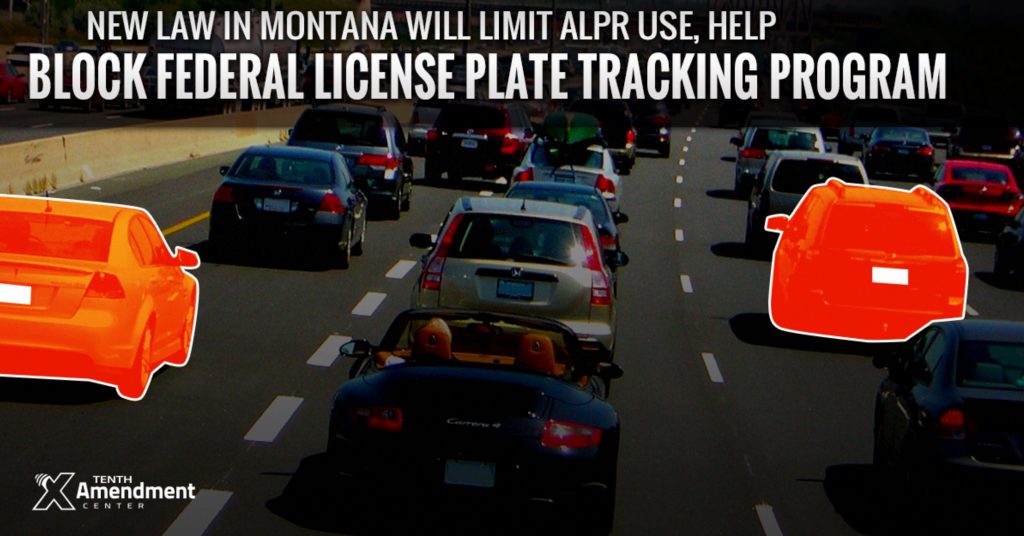Tomorrow, a Montana law that limits the use of Automated License Plate Readers (ALPRs) in the state goes into effect. The new law will also place significant roadblocks in the way of a federal program using states to help track the location of millions of everyday people through pictures of their license plates.
Rep. Daniel Zolnikov (R-Billings) sponsored House Bill 149 (HB149). The legislation prohibits the use of ALPRs except for specified purposes, and also places limitations on the retention and sharing of data gathered by license plate readers.
The Montana Senate passed HB149 by a 48-1 vote. The House concurred with a 91-7 vote, With Gov. Steve Bullock’s signature the law goes into effect Oct. 1.
Under the law, law enforcement agencies can only use ALPRs for specified law enforcement purposes. These include identifying stolen vehicles, locating missing persons, locating individuals with outstanding warrants, locating vehicles involved in homicides or other major crimes, and “case-specific investigative surveillance.”
Any data collected by an ALPR cannot be stored from more than 90 days without a preservation request, or a state or federal warrant. A preservation request will only be valid for one year and will have to be renewed for continuing data storage.
The original bill contained language prohibiting an ALPR system from photographing, recording, or producing images of the occupants of a vehicle. That was unfortunately removed during the committee process.
Even so, this law will prevent the state from creating permanent databases using information collected by ALPRs, and make it highly unlikely that such data will end up in federal databases.
IMPACT ON FEDERAL PROGRAMS
As reported in the Wall Street Journal, the federal government, via the Drug Enforcement Agency (DEA), tracks the location of millions of vehicles. They’ve engaged in this for over eight years, all without a warrant, or even public notice of the policy.
State and local law enforcement agencies operate most of these tracking systems, paid for by federal grant money. The DEA then taps into the local database to track the whereabouts of millions of people – for the simple act of driving – without having to operate a huge network itself.
Since a majority of federal license plate tracking data comes from state and local law enforcement, passage of this legislation takes a major step toward blocking that program from continuing in Montana. The feds can’t access data that doesn’t exist.
“No data means no federal license plate tracking program,” Tenth Amendment Center founder and executive director Michael Boldin said.
Law enforcement generally configures ALPRs to store the photograph, the license plate number, and the date, time, and location of vehicles. But according to newly disclosed records obtained by the ACLU via a Freedom of Information Act request, the DEA also captures photographs of drivers and their passengers.
According to the ACLU:
One internal 2009 DEA communication stated clearly that the license plate program can provide “the requester” with images that “may include vehicle license plate numbers (front and/or rear), photos of visible vehicle occupants [redacted] and a front and rear overall view of the vehicle.” Clearly showing that occupant photos are not an occasional, accidental byproduct of the technology, but one that is intentionally being cultivated, a 2011 email states that the DEA’s system has the ability to store “up to 10 photos per vehicle transaction including 4 occupant photos.
With the FBI rolling out facial a nationwide recognition program last fall, and the federal government building biometric databases, the fact that the feds can potentially access stored photographs of drivers and passengers, along with detailed location data, magnifies the privacy concerns surrounding ALPRs.
The new Montana ALPR limits take a good first step toward putting a big dent in federal plans to continue location tracking, and expanding its facial recognition program. The less data the state makes available to the federal government, the less ability they have to track people in Montana, and elsewhere.
Source Article from http://feedproxy.google.com/~r/ActivistPost/~3/rycJSpD9qFc/new-montana-law-limits-alpr-use-helps-block-national-license-plate-tracking-program.html
Related posts:
Views: 0
 RSS Feed
RSS Feed

















 October 1st, 2017
October 1st, 2017  Awake Goy
Awake Goy 
 Posted in
Posted in  Tags:
Tags: 
















